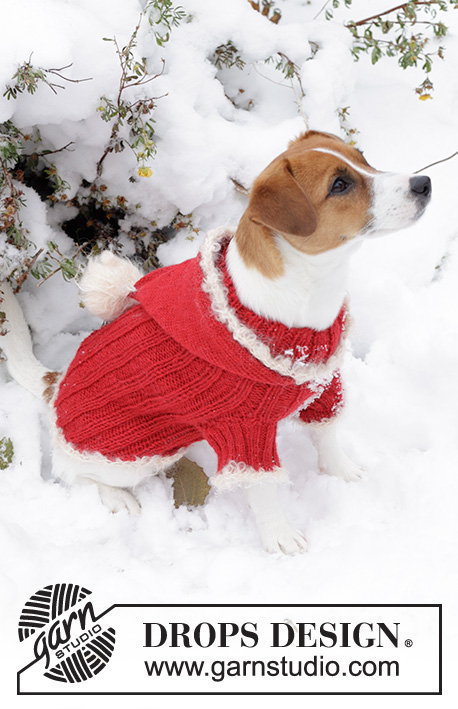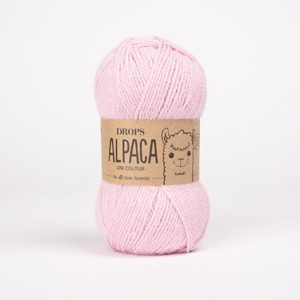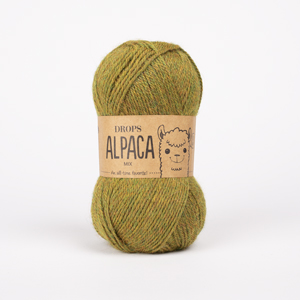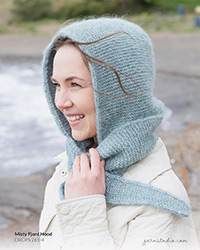Comments / Questions (26)
![]() Muriel wrote:
Muriel wrote:
Bonjour, Merci pour ces modèles gratuits :) Que me conseillez-vous pour convertir celui-ci que je souhaite réaliser au crochet ? Merci de vos conseils ! Muriel
15.10.2025 - 18:13DROPS Design answered:
Bonjour Muriel, nous n'avons pas vraiment de conversion tricot vers le crochet je suis désolée, essayez de contacter votre magasin ou un forum crochet où vous pourrez fort probablement trouver une assistance. Bon crochet!
16.10.2025 - 17:22
![]() Teri wrote:
Teri wrote:
I found the answer to my question in the tutorial videos. Sorry for the trouble. Thank you.
13.06.2022 - 02:01
![]() Annick Desnoyers wrote:
Annick Desnoyers wrote:
Bonjour, Après le montage des 64 mailles, on tricote un rang à l'envres. J'ai tout de suite monté les 90 mailles pour la capuche. Est-ce ainsi que l'on doit procéder ? Merci.
27.04.2019 - 18:41DROPS Design answered:
Bonjour Mme Desnoyers, on doit monter 64 m dans la 2ème taille et 80 m dans la 3ème taille, puis tricoter 6-8 cm de côtes 2/2. On tricote ensuite 1 tour envers, puis au tour suivant, on tricote en côtes comme avant, et, en même temps, on augmente 1 maille env dans 1 section env sur 2 (= 8-10 augmentations) = on a maintenant 72/90 m. On tricote ensuite les mailles comme elles se présentent puis on augmente 1 m env dans les sections 2 m env restantes (= 8-10 augmentations) = 80-100 m. On continue alors en côtes 2 m end/3 m env. Bon tricot!
29.04.2019 - 09:35
![]() Mariarita wrote:
Mariarita wrote:
Spettabile Staff,buongiorno.Volevo augurare a tutti Voi serene festività.Un gaio 2019,all'insegna della creatività ed in compagnia del Vs. colorato e fantasioso mondo del crochet e del knitting.Grazie.
21.12.2018 - 11:24DROPS Design answered:
Buongiorno Mariarita. Ringraziamo e ricambiamo gli auguri per queste Feste!!
21.12.2018 - 13:01
![]() Susan wrote:
Susan wrote:
I am stuck at "divide for legs: Bind off 2 K sts slip next 18 bind off 2 K sts. If you bind off 2 K sts you have your working yarn on the 1st purl stitch which is counted as 1st st of 18 in order to bind off 2 K sts after 18. However, how do you bind off two K sts after the 18 that were slipped onto stitch holder when working yarn is at the beginning of the 18 slipped sts?
14.12.2017 - 09:20DROPS Design answered:
Dear Susan, bind off the first 2 sts on round, work the next 17 sts (+ 1 st on needle after binding off 2nd st) and slip them on a st holder, bind off next 2 sts and work to end of row = 58 sts remain for back piece. Happy knitting!
14.12.2017 - 10:35
![]() Susan wrote:
Susan wrote:
Can this pattern be made with one strand of worsted weight instead of two strands of yarn?
07.12.2017 - 23:37DROPS Design answered:
Dear Susan, You can use here 1 strand yarn group C instead of 2 strands yarn group A (as Alpaca). Read more here about alternatives. Happy knitting!
08.12.2017 - 08:31
![]() Lilou wrote:
Lilou wrote:
Je trouve déplorable la nouvelle présentation de votre site. Je suis passée par google pour retrouver un modèle avec son numéro!!. Vous donnez différentes possibilités en allant sur le ?. mais dans quoi chercher??... C'était beaucoup plus simple avant!!
24.11.2016 - 10:13DROPS Design answered:
Bonjour Lilou, nous sommes désolées que vous ayez du mal à vous faire à la nouvelle présentation, vous pouvez désormais accéder à n'importe quel modèle à partir de notre site en indiquant son numéro dans la case "Cherchez des modèles!" - plus d'infos ici, et vous avez désormais à votre disposition des filtres bien utiles pour cibler votre recherche. Bon tricot!
24.11.2016 - 11:51
![]() Julie wrote:
Julie wrote:
Hello, can you tell me if the hood is knitted on 3mm or 4mm needles with one or two strands? The pattern is not really clear. Thank you for your help.
11.11.2016 - 16:36DROPS Design answered:
Dear Julie, hood is worked with 2 strands Alpaca and needle size 4 mm (as for body) - needle size 3 mm are only used for the edge around legs. Happy knitting!
14.11.2016 - 08:50
![]() Caroline wrote:
Caroline wrote:
Hej! Undrar lite med minskningen under magen vid 20-28-35 cm. Ska det minskas 10 maskor och mitt i detta så delas arbetet så man avmaskar på varje varv sen eller ska det avmaskas 10 maskor mitt under magen? Mvh caroline
29.08.2014 - 20:27DROPS Design answered:
Om du stickar S avm 10 m under magen när arb mäter 28 cm. Sedan avm det i varje sida enligt beskrivningen.
03.09.2014 - 11:28
![]() Alex wrote:
Alex wrote:
Merci beaucoup, ça paraît logique maintenant que vous le dites :) Merci également pour les diverses explications, ce site est une vraie mine d'informations.
10.03.2014 - 21:22
Santa's BFF#santasbffsweater |
|
 |
 |
Knitted dog jumper in DROPS Alpaca and DROPS Puddel or Melody. The piece is worked from neck to tail with rib, hood and crocheted edges. Sizes XS - M. Theme: Christmas
DROPS Extra 0-521 |
|
|
------------------------------------------------------- EXPLANATIONS FOR THE PATTERN: ------------------------------------------------------- GARTER STITCH (worked back and forth): Knit all rows. 1 ridge = knit 2 rows. ------------------------------------------------------- START THE PIECE HERE: ------------------------------------------------------- DOG JUMPER - SHORT OVERVIEW OF THE PIECE: The piece is worked from neck to tail. The neck and yoke are worked in the round. The yoke is divided for the front legs and the back and tummy worked separately, back and forth. The piece is re-joined and worked in the round, then the body is finished back and forth. The legs are worked in the round, the hood back and forth. Edges are crocheted around the front legs, body and hood and a pom pom fastened to the top of the hood. NECK: Cast on 48-64-80 stitches with double pointed needles/circular needle size 4 mm and 2 strands DROPS Alpaca. Work rib in the round (knit 2, purl 2) for 4-6-8 cm. Purl 1 round (you will knit up stitches in this round for the hood). Work 1 round of rib as before. On the next round increase every other purl-2 to purl-3 = 54-72-90 stitches. YOKE: Continue the new rib until the piece measures 6-10-14 cm. Now increase the remaining purl-2 to purl-3 = 60-80-100 stitches. Continue the new rib (knit 2, purl 3). When the piece measures 8-12-16 cm divide for the front legs as follows: Cast off 2 knitted stitches, place the next 13-18-23 stitches on 1 thread (= mid-tummy), cast off 2 knitted stitches, work the remaining 43-58-73 stitches as before. BACK: = 43-58-73 stitches. Continue the rib back and forth until the piece measures 5-8-10 cm from the division. Place the stitches on 1 thread. TUMMY: Place the 13-18-23 tummy-stitches back on the needle and work rib back and forth for 5-8-10 cm. BODY: Place all stitches on the needle. Continue rib in the round AT THE SAME TIME cast on 2 stitches in each side between the tummy and back = 60-80-100 stitches. When the piece measures 20-28-35 cm cast off 9-10-13 stitches mid-tummy. Finish the piece back and forth. AT THE SAME TIME, cast off on each side at the beginning of each row as follows: 2 stitches 2 times, 1 stitch 2-5-7 times, 2 stitches 1 time and 3 stitches 1 time. Cast off the remaining 29-42-55 stitches. The piece measures approx. 25-35-45 cm. FRONT LEGS: Knit up 36-52-64 stitches around the leg-opening, with 1 strand DROPS Alpaca and double pointed needles size 3 mm. Work rib (knit 2, purl 2) for 3-5-7 cm, cast off with rib. Repeat around the other leg-opening. HOOD: Fold the neck to the wrong side along the purled round. Hold the jumper with this round away from you. Use 1 strand DROPS Alpaca and circular needle size 3 mm and knit up stitches around the neck (do not knit up in the 6-10-14 stitches mid-tummy) = 42-54-66 stitches. Purl 1 row back and increase to 70-90-110 stitches as follows: * Purl 1, purl 2 stitches in each of the next 2 stitches *, work from *-* to end of row. Work stocking stitch back and forth with 3 GARTER STITCH – read explanation above, on each side, until the hood measures 12-16-20 cm. For a neat finish, graft the stitches at the top together without casting off, or cast off and sew together with grafting stitches. CROCHET-EDGES: Using hook size 6 mm and DROPS Puddel or DROPS Melody, crochet an edge around the hood, the bottom of each leg and the bottom edge of the body – make sure the edges are not tight. Fasten the strand with 1 slip stitch and work as follows: 1 chain stitch, * 1 chain stitch, skip 1 cm, 1 double crochet in next stitch *, work from *-* and finish with 1 chain stitch, skip 1 cm and work 1 slip stitch in the chain stitch at the beginning of the round. POM POM: Make 1 pom pom, 5 cm in diameter with DROPS Puddel or DROPS Melody. Fasten to the top of the hood. |
|
Have you finished this pattern?Tag your pictures with #dropspattern #santasbffsweater or submit them to the #dropsfan gallery. Do you need help with this pattern?You'll find 20 tutorial videos, a Comments/Questions area and more by visiting the pattern on garnstudio.com. © 1982-2026 DROPS Design A/S. We reserve all rights. This document, including all its sub-sections, has copyrights. Read more about what you can do with our patterns at the bottom of each pattern on our site. |
|





































































Post a comment to pattern DROPS Extra 0-521
We would love to hear what you have to say about this pattern!
If you want to leave a question, please make sure you select the correct category in the form below, to speed up the answering process. Required fields are marked *.